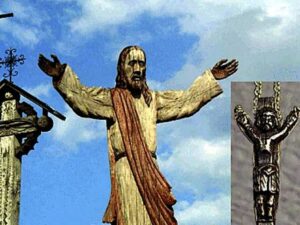


Hesus (also spelled Esus) is a deity associated with the ancient Celtic religion, known primarily from Roman and Gallo-Roman sources. The information about Hesus is somewhat limited and fragmentary, primarily derived from inscriptions, iconography, and the writings of Roman authors.
Key Points about Hesus:
- Name and Etymology: The name Hesus (or Esus) is believed to be of Celtic origin. The etymology is unclear, but some scholars suggest it might be related to the Proto-Celtic word for “lord” or “master.”
- Historical Sources:
- Lucan: The Roman poet Lucan mentions Hesus in his epic poem “Pharsalia,” where he is depicted alongside other gods such as Taranis and Teutates. Lucan describes rituals involving human sacrifice, though these accounts are subject to debate among scholars regarding their accuracy and potential Roman bias.
- Inscriptions: A few inscriptions mentioning Hesus have been found. One notable example is the Pillar of the Boatmen, a Gallo-Roman monument from Paris (Lutetia), which depicts various gods including Hesus, who is shown cutting branches from a tree.
- Iconography and Depictions: In the imagery found on the Pillar of the Boatmen, Hesus is depicted as a woodcutter with an axe, involved in cutting a tree. This has led some scholars to speculate that he might have been a god associated with forestry, agriculture, or even life and death cycles.
- Role and Characteristics:
- Nature and Agriculture: Due to his depiction with an axe and a tree, Hesus is often considered to be a god related to nature, trees, or agriculture.
- Possible Warrior Aspect: Some interpretations suggest a warrior aspect, potentially linked to the sacrificial practices mentioned by Lucan.
- Modern Interpretations and Legacy: In modern times, Hesus, like many other Celtic deities, has been subject to various interpretations and has become part of neo-pagan and modern Celtic spiritual practices. His image as a nature god often aligns with contemporary ecological and nature-revering spiritual movements.
Due to the sparse and often ambiguous historical records, much about Hesus remains speculative, and interpretations vary widely among scholars and modern practitioners.